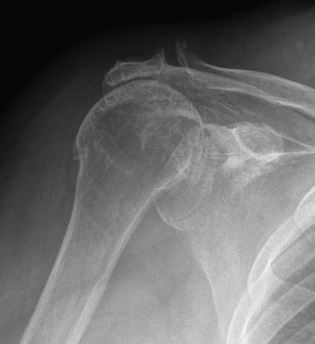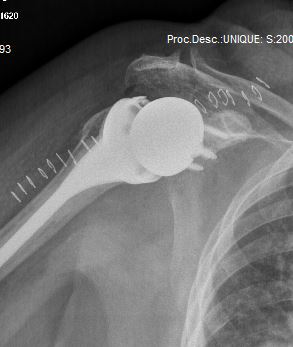Reverse Total Shoulder Replacement
A surgical procedure performed to replace arthritic joint surfaces of the ball and socket of the shoulder in the setting of a nonfunctional rotator cuff. An incision is made on the front of the shoulder and the shoulder joint is exposed. The damaged areas of the ball and socket are removed. A metal stem is placed in the humerus bone and secured. An appropriately sized cup component is then attached to the stem. The ball component is fixed to bone of the native socket using screws. Once the components are secured the shoulder is checked to ensure appropriate range of motion and stability of the implants.

Contents
Common Questions About Reverse Total Shoulder Replacement
What is a reverse total shoulder replacement?
A reverse shoulder replacement is a unique replacement because in addition to replacing the ball and the socket with metal and plastic, the positions are “reversed”. The ball gets implanted where the socket usually is on the scapula. The socket gets implanted where the ball usually is on the humerus.
When is a reverse shoulder replacement necessary?
A reverse total shoulder replacement is necessary when the rotator cuff is torn and irreparable and the shoulder has osteoarthritis. Because there is no rotator cuff the shoulder ball and socket must be “reversed” so that the deltoid muscle can act as a lever to elevate the arm.
Who should have reverse shoulder replacement surgery?
Patients with rotator cuff arthropathy, or arthritis caused by deficiency of the rotator cuff. In this type of arthritis, the ball begins to grind on the undersurface of the acromion process of the scapula.
Where is the incision for a shoulder replacement?
It is in the deltopectoral interval between the deltoid and pectoralis muscle above the axilla.
How long do shoulder replacements last?
Shoulder replacements have been reported to last 10 to 20 years depending on the activity level of the patient.
What is the rehabilitation after a shoulder replacement?
Generally, after a shoulder replacement a patient wears a sling for 6 weeks and then performs physical therapy and rehabilitation for 2 to 3 months.
Example X-Ray Images
Non-United Fracture of Proximal Humerus

Cuff Tear Arthropathy

Reverse Total Shoulder Replacement











